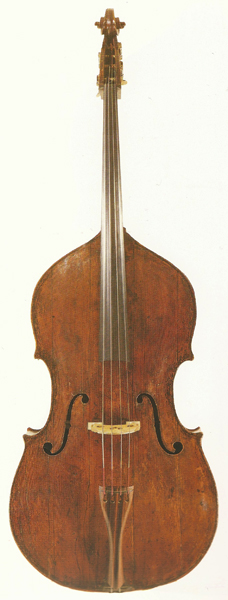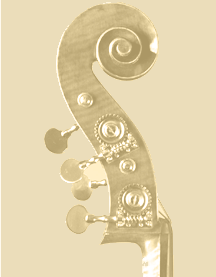Italian Double Bass
 Italian
double basses are the most esteemed and most sought after upright
basses in the world. Just why are Italian basses so popular?
Who are the most important makers? What makes the Italian upright bass
different and special? Italian
double basses are the most esteemed and most sought after upright
basses in the world. Just why are Italian basses so popular?
Who are the most important makers? What makes the Italian upright bass
different and special?
There is certainly an "aura" surrounding Italian basses.
Let's make a list of some noteworthy, distinctive characteristics
that tend to pertain to Italian upright basses. First of all,
there is a huge spectrum of parameters that these basses fall
within. It's even more interesting that so many of these
traits found also overlap into other bass makers and country of
origins.
Some noteworthy characteristics of Italian double
basses:
- Unlike the big, broad, flat backed, English double bass, Italian basses
come in all shapes and sizes. Most Italian basses tend to
be on the medium to larger side when comparing to other double
basses. (For instance, you are less likely to see too many 7/8
sized French, Czech, Bohemian and while they're are some bigger German
basses, not nearly as many as the English and Italians.
- Italian double basses have both flat backs and carved backs,
but most Italian makers still made their basses in a modified
violin form. By violin form, that is, still using the
violin corners as one would normally find on violins or cellos.
Still, the upper shoulder forms of these basses were rarely
"full" formed (as a violin) because of the overwhelming mass in
size. (Anyone that has played a cello of a violin model bass
(with the shoulders straight out) will know how difficult it is
to play these basses. Many Italian upright basses still have (or
had) very broad shoulders, but through the years have been modified
(or actually "cut down") to make it easier to play on.
Also, up until the early 1900's the necks were still set deep
into the bass. Not like today's double basses, the
necks were set deeply into the bass neck block. While this
gave the it less tension on the bass top, they were also harder to play on
and around. Almost all Italian basses were built this way,
and most all of these basses today have had their necks pulled
out and re-seated (brought out about an extra 1/2-1") to make the bass easier
to play on and to also bring out more projection of the sound.
(All the Strad violins where built like this and only one Strad
(today) remains with the neck seated as it was originally.
Woods used on Italian upright basses:
By and large, still the most popular woods used on Italian
basses, would be maple. Like their best violins, violas and
cellos, maple was "saved" for the best instruments. Historically the
upright bass seems to have always been considered a "2nd class
citizen" by other makers.
This topic alone can be better served in a separate article, but
suffice to say there were many factors that surely "added up" for
Italian double bass makers. For one, no matter when or where
you lived (throughout) history, good wood, has never been cheap.
(Some things never change!) In fact, even then the Italians
imported their wood from Bosnia. The Bosnian maple is most
noted for it's sound and tonal characteristics as well as its
beauty. The colder climate was perfect (for maple) in Bosnia.
Still so, Italians used different woods for their larger
instruments. They used more local, (cheaper) woods and to be
fair, many of the basses using softer woods like poplar and walnut,
tended to have a slightly different tonal character as well.
Here is a contemporary model
Giovanni
Battista Rogeri upright bass made in China. (These basses worked
in the 18th century...and the same shape, form works today.)
Today, the most popular Italian models to copy are still the
Rogeri and Cerruti models because of the sound depth and tone, as
well as the size being more playable.
Noteworthy Italian bass makers
It's well documented that Antonio Stradivarius never made a bass.
That's too bad and I am sure that many bass makers throughout
history have wondered what one would have been like. Just like
their violins, Italian basses command the highest prices, but it is
still interesting that makes often most noted for their violins
(that are credited with making basses) don't always have the best
made or sounding basses! There are lots of obscure
Italian bass makers that made incredibly great basses and that was
their specialty. For example, while Testore violins are
special, (mostly noteably CG Testore), the
violins are not especially acclaimed as are the basses or cellos.
>/p>
The most expensive Italian basses today, are from Cremona, Italy
(18th century): Giovanni Battista Rogeri, Nicola Bergonzi, Giovanni
Battista Ceruti, Giovanni Paulo Maggini, Gaspar da Salo, Matteo Gofriller Others include: the Testores (Carlo Antonio, Carlo
Giuseppe, Gennaro, Giovanni, Paulo Antonio). For the Testore
name, there's been lots of abuse by people selling "Testore" basses
throughout history. When in doubt....just calling it a Testore!
Just to name a few other makers: Amati, Albani, Antoniazzi, Baldentoni,
Balestieri, Bracci, Cavallini, Corain, Cristofori, Degani, Fiorini,
Gagliano, Guadanini, Grancino, Guarnerius, Montagnana and Panormo.
(Panormo is really one of the most sought after basses as they are
built really well, sound great, and made by an Italian in England...which
makes is an Italian/English bass!) There are just too many
names to list here, but there are some really interesting books
to collect: Duane Rosengard's Cremonese Double Basses,
Richard Elgar's Looking at the Double Bass, as well as
subscribing to the International Society of Double Bassists
which always highlights some great bass with a good description
of the bass, measurements and any historical background of the maker.
Got a question about any of our double basses? Give us a call (800-600-2689)
or email
Steve.
|


